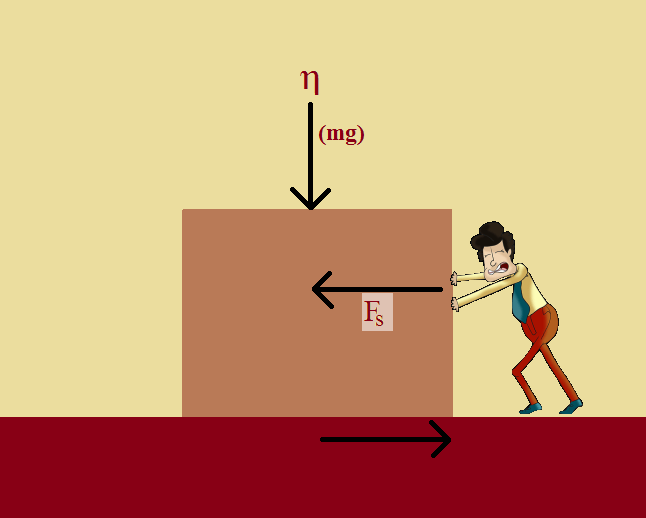 You return home. You find that while you were gone, the UPS man dropped off a large cardboard box in front of your garage. The box is made of very thick cardboard. Clouds are rolling in. You need to put the box in the garage. But it’s just you and the box is super-heavy. You have no alternative but to push it in.
You return home. You find that while you were gone, the UPS man dropped off a large cardboard box in front of your garage. The box is made of very thick cardboard. Clouds are rolling in. You need to put the box in the garage. But it’s just you and the box is super-heavy. You have no alternative but to push it in.
You Take Note
You’ve had your coffee today, so you’re on top of your game. Your mind is sharp as it will ever get. You position your hands and shove the box with everything you’ve got. You give it your best! Curiously once it starts, it isn’t that hard to move, as long as you keep moving.
You realize with that Sherlock Holmes brain of your that you’ve just fought friction and won. And you realized the friction before the box started moving seemed hard compared to the friction once it was moving.
The first kind of friction is termed static friction. The second kind is dynamic or sliding friction. What’s that all about?
Definition of Friction?
One simple definition of friction as a whole is “the resistance the surface of one object experiences when it is moved over another object.” In reality, this definition reveals very little.
It tells us nothing about the interactions producing the resistance. Experience suggests there should be friction no matter what, though the nature of those surfaces must play a role.
Force and Sir Isaac Newton

Since it takes force to move one object over another, we begin by considering Newton’s 3rd Law of Motion: For every action, there must be an equal and opposite reaction. That is, for every force applied, there is a force pushing back.¹
As long as the force we push with is not greater than the force pushing back, the box will not slide; it will stand still. This is the force exerted to overcome static friction, Fs. It says, “Uh, uh, I ain’t movin’.”
But why the force? Well, imagine a really fat man (at over 300 lbs., I volunteer) sits on top of the box. It will require a great deal more force to push the box. A no-brainer deduction tells us gravity is a major factor. We are already familiar with the equation that weight (our normal force) = mg. That is, weight = mass x gravity. So η = mg.
For now, we will consider gravity as a key component in the “normal” (perpendicular) force. It is symbolized by the Greek letter η. Let’s generate a simple equation based on our observations. We want to determine the amount of force we must use to just get the box moving. We’ll call that Fsmax.
Now we come to the best part…
Every Good Scientist
Every science student knows that every good scientist, when he needs to make an equation balance, inserts a “fudge factor”. We are no exception. Hence, let us pick for our fudge factor, μs. That we’ll call the coefficient of static friction.
Now let us introduce our equation:
Fsmax = μs · mg
Now I mentioned every “good” scientist. So where is the good science? It remains locked up inside the μs! We will attempt to unravel that, shortly. First, let’s consider kinetic friction.
Kinetic Friction
We won’t run around Aunt Jane’s barn with this one. The same form of equation attains in this instance, that is, it closely compares to the equation for static friction. Only the coefficient is different. The coefficient of kinetic friction is μk.
Fsmax = μk · mg
As our box outside the garage illustration suggests, μk < μs. Once we’ve gotten over the friction “hump”, keeping the box moving is easier.
The Nitty Gritty
Now back to causes and the difference between static and kinetic friction. What causes friction? Actually, that is a very complex topic. There are probably many contributors to friction. There are factors at work such as surface roughness, hydrogen bonding, and Van der Waal’s forces.
These characteristics are not easy to quantify and vary from surface to surface. Hence even “good scientists”, or perhaps we should say “good engineers”, use the aforementioned fudge factors, the coefficients of static and of kinetic friction, in their calculations.
Extra Credit:
Have some time to spend to watch an intriguing 2-part television show that is:
- Exceptionally entertaining
- Highly educational
- A show with international appeal
Then here you go!
The Battle of the Extreme Bar Slide Part One
The Battle of the Extreme Bar Slide Part Two
1 Although there always two forces involved, it is sometimes the case that the 2nd force is not easy to visualize. Such is the case in this instance.
Note: You might also enjoy The Four Fundamental Forces of Nature
References:

Yes, I think everyone must have realised at some time, including husky dogs, that the effort required to start something moving is greater than that required to KEEP it moving but I didn’t realise they were called static and kinetic friction. Your term about getting over the “hump” of static friction reminds me of a lecture I remember from chemistry on ignition. That lecture mentioned a hump that had to be overcome for something to set alight but once attained, it burned away merrily. And some substances had lower thresholds than others.